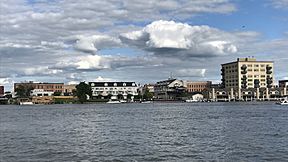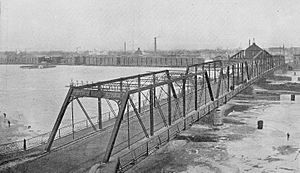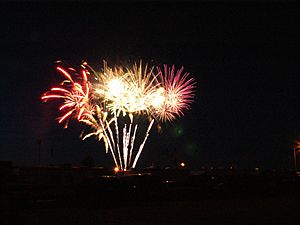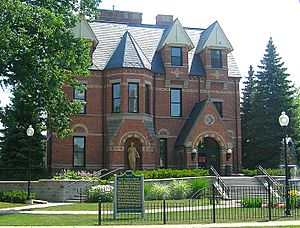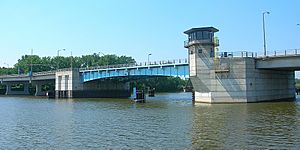Bay City, Michigan facts for kids
Quick facts for kids
Bay City, Michigan
|
|
|---|---|
|
Bay City from across the Saginaw River
|
|
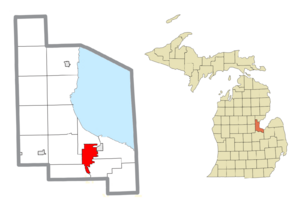
Location within Bay County
|
|
| Country | United States |
| State | Michigan |
| County | Bay |
| Settled | 1831 |
| Incorporated | 1865 |
| Government | |
| • Type | Council–manager |
| Area | |
| • City | 11.20 sq mi (29.01 km2) |
| • Land | 10.17 sq mi (26.33 km2) |
| • Water | 1.03 sq mi (2.68 km2) |
| Elevation | 585 ft (178.3 m) |
| Population
(2020)
|
|
| • City | 32,661 |
| • Density | 3,212.77/sq mi (1,240.51/km2) |
| • Urban | 70,585 (US: 390th) |
| • Metro | 107,110 (US: 335th) |
| Time zone | UTC-5 (EST) |
| • Summer (DST) | UTC-4 (EDT) |
| ZIP code(s) |
48706–48708
|
| Area code(s) | 989 |
| FIPS code | 26-06020 |
| GNIS feature ID | 0620777 |
Bay City is a city in and the county seat of Bay County, Michigan, United States. The population was 32,661 as of the 2020 census. The city is located just upriver from the Saginaw Bay on the Saginaw River. It is the principal city of the Bay City metropolitan area, which is coterminous with Bay County as part of the larger Greater Tri-Cities region of Central Michigan. Several historic bridges cross the Saginaw River in Bay City, including Liberty Bridge, Veterans Memorial Bridge, Independence Bridge, and Lafayette Avenue Bridge.
Contents
History
Leon Tromblé is regarded as the first settler within the limits of Bay County, in an area which would become Bay City. In 1831, he built a log cabin on the east bank of the Saginaw river. Bay City was first established in 1837 and was incorporated as a city in 1865. In 1834 John B. Trudell built a log-cabin near the present corner of Seventeenth and Broadway. Trudell later purchased land that extended from his residence north along the river to what later became the location for the Industrial Brownhoist, making him the first permanent resident of what has become Bay County. Bay City became the largest community in the county and the location of the county seat of government. Most of the county's agencies and associations are located here. The city shares common borders with Essexville and the townships of Bangor, Frankenlust, Hampton, Merritt, Monitor, and Portsmouth.
Bay City was originally known as "Lower Saginaw," and fell within the boundaries of Saginaw County. On June 4, 1846, the Hapton, or Hampton, Post Office opened to service Lower Saginaw. The community was placed in Bay County, when the county was organized in 1857. It was at this time that the name was changed to Bay City. The Post Office changed its name to Bay City on March 22, 1858.
While Saginaw had the first non-native settlement in this area in 1819, larger ships had difficulty navigating the shallower water near the Saginaw settlement. Many of the early pioneers moved to Lower Saginaw as it became clear its deeper waters made it a better location for the growth of industry which relied on shipping. By 1860, Lower Saginaw had become a bustling community of about 2,000 people with several mills and many small businesses in operation. In 1865, the village of Bay City was incorporated as a city. Rapid economic growth took place during this time period, with lumbering, milling, and shipbuilding creating many jobs. The early industrialists in the area used the Saginaw River as a convenient means to float lumber to the mills and factories and as a consequence amass large fortunes. Many of the mansions built during this era are registered as historical landmarks by the state and federal government.
In 1873, Charles C. Fitzhugh, Jr., a Bay City pioneer, and his wife, Jane, purchased land and built a home on property bounded by Washington, Saginaw, Ninth and Tenth Streets, which later became the location for City Hall. Fitzhugh dealt on a large scale in wild lands and farms, being an agent for over 25,000 acres (100 km2) of land in Bay County. During this time, Washington Avenue was primarily developed with residential homes. Businesses were concentrated along Water Street near the Saginaw River. As time went on, businesses started to expand along Washington Avenue. In 1891, the Fitzhughs sold the land to the City of Bay City for $8,500 "to be used for the erection of a City Hall and offices and for no other purposes whatever."
Until 1905, the City of Bay City was limited to the east bank of the Saginaw River. when West Bay City was annexed.
During the latter half of the 19th century, Bay City was the home of several now-closed industries including many sawmills and shipyards. The Defoe Shipbuilding Company, which ceased operations December 31, 1975, built destroyer escorts, guided missile destroyers, and patrol craft for the United States Navy and the Royal Australian Navy. To maintain this strong Naval heritage, the Saginaw Valley Naval Ship Museum worked through the Naval Sea Systems Command to bring the USS Edson (DD-946) to Bay City as a museum ship. It was finally delivered to its temporary home in Essexville, Michigan, on August 7, 2012. Another important part of the city's industrial history is Industrial Brownhoist, which was well known for its construction of large industrial cranes.
At the outbreak of the First World War, Bay City contained a largely German neighborhood called Salzburg. The German-descended minority became the focus of extreme nativism and xenophobia. Pastors introduced English-language sermons for the first time in Salzburg but it did not catch on and sermons in Salzburg remained mostly German. The Salzburghers demanded that the rest of Bay City recognize them as Americans first and German-American second but hostility towards them continued. The governor of Michigan at the time, Albert Sleeper, sought support from the German-American community but experienced backlash. Even before the declaration of war against Germany, anti-German sentiment was so strong that hundreds of young men from Michigan had gone across the border to Canada to join the Canadian Armed Forces so as to be a part of the war effort.
Notable events
On December 23, 1906, Bay City's premier hotel, the Fraser House, burned to the ground.
Bay City's unusual Third Street Bridge was damaged by a freighter on June 17, 1976. The following morning, when the swing span was operated, one half crashed into the Saginaw River blocking all riverine traffic. A river crossing was never reinstated at that location.
On December 10, 1977, a deadly fire claimed the lives of 10 at the Wenonah Hotel (Wenonah Park Apartments) in downtown Bay City. The hotel had been built on the site of the Fraser House, which had also succumbed to a fiery end. The Wenonah Hotel was located at the corner of Center Ave and Water Street, the current site of the Delta College Planetarium. Built in 1907, the four-storey Wenonah Hotel had been converted into apartments at the time of the fire. Strong winds and cold weather hampered the efforts of the fire department. There was some controversy over the cause of the fire (arson, electrical, or grease fire) and it remains the deadliest fire in Bay County history.
On Christmas Eve, 1979, a large Bay City department store of long standing, Oppenheim's, was destroyed by fire.
In September 1990, the tankship MV Jupiter was unloading gasoline at the Total Petroleum Terminal. A passing cargo ship, MV Buffalo, moving at excessive speed, created a wake that caused Jupiter to break free of its berth. A fire and explosion ensued, and one man drowned. There was considerable legal action taken, ultimately resulting in an adjudication that was subsequently appealed by the owners of Buffalo. The findings of the Court of Appeals upheld the original decision, which assigned 50% of the responsibility to Buffalo (for her excessive speed), 25% to the dock operator (for rotten wood pilings) and 25% to Jupiter (for improper procedures in unloading her cargo).
In January 2009, Bay City's wholly owned municipal power company, Bay City Electric Light and Power, installed a "limiter" device to restrict the receipt of power to the home of Marvin Schur, a 93-year-old customer who had failed to pay an outstanding bill in excess of $1,000. The Bay City Electric Light and Power policy was to install the limiter, and to notify the customer by trying to collect the amount due. City employees failed to knock on the door, and it was later found that Schur had a check already made out and had failed to mail it. Schur died from hypothermia in his home a few days later. The day following his death, Bay City Electric Light and Power removed the limiters from all households. It was later learned that Schur had willed his estate, estimated by his family to be in excess of $500,000, to Bay Regional Medical Center.
On October 12, 2010, the historic 113-year-old City Hall sustained significant damage as the result of an attic fire which caused the sprinkler system to run for nearly two hours. Most of the damage to the building was water damage from the sprinkler system and water used to fight the fire. The fire started in the midst of a $1.6 million roofing project. After an investigation, it was determined that a worker was using a grinder to cut off bolts in the area where the fire started, and sparks from the work started the blaze. Fire crews were on the scene for nearly five hours fighting the hard-to-access fire.
Geography
According to the United States Census Bureau, the city has a total area of 11.21 square miles (29.03 km2), of which 10.17 square miles (26.34 km2) is land and 1.04 square miles (2.69 km2) is water. Despite declining population, Bay City remains (by a narrow margin over Port Huron) as the largest U.S. city by population on or near Lake Huron, much smaller than the largest cities on the other four Great Lakes: (Chicago, Toronto, Cleveland, and Thunder Bay).
Bay City, along with Saginaw, and Midland make up the Tri-Cities Area, a sub-region of Flint/Tri-Cities. Bay City is sometimes regarded as being part of the greater Thumb of Michigan Area, which is also a sub-region of the Flint/Tri-Cities.
Neighborhoods
- West Bay City is a section of the city on the West side of the Saginaw River that was a former city.
- The Center Avenue Historic District is an area of the city with more than 250 buildings on the National Historic Register, many of them being old houses built during the lumber boom era in the state.
Business districts
- Banks Business District – Runs along Marquette Avenue from Ohio Street north to Harry S. Truman Parkway
- Broadway Avenue Business District – Extending from Lafayette Avenue south to McGraw Avenue
- Columbus Avenue Business District – From Washington Ave to Bay Medical Center Hospital
- Downtown Bay City – Between Madison Avenue and the Saginaw River.
- Johnson Street Business District – From Center Ave to Woodside St.
- Lafayette/Salzburg/Kosciuszko Business District – Extends along Salzburg east to Kosciuszko (Lafayette turns into Kosciuszko).
- The Midland Street Historic District – Located on the West side of the city near the banks of the river. Home to many popular bars in the city.
- Industrial Districts – Morton Street, Harrison Street, Woodside Avenue, and the Marquette Industrial Center. Home to companies such as: General Motors Powertrain, SC Johnson & Son, Carbone of America/Ultra Carbon Division, Kerkau Manufacturing, Gougeon, and York Electric
- Bay City Town Center area (not located within the city limits, but in the adjoining township of Bangor Township) – Wilder Road at State Street Road.
- Water Street – home to Michigan's largest antique district
- Uptown Bay City - located along the Saginaw River, just south of Veteran's Bridge.
Climate
This climatic region is typified by large seasonal temperature differences, with warm to hot (and often humid) summers and cold (sometimes severely cold) winters. According to the Köppen Climate Classification system, Bay City has a humid continental climate, abbreviated "Dfb" on climate maps.
Demographics
| Historical population | |||
|---|---|---|---|
| Census | Pop. | %± | |
| 1860 | 1,583 | — | |
| 1870 | 7,064 | 346.2% | |
| 1880 | 20,693 | 192.9% | |
| 1890 | 27,839 | 34.5% | |
| 1900 | 27,628 | −0.8% | |
| 1910 | 45,166 | 63.5% | |
| 1920 | 47,554 | 5.3% | |
| 1930 | 47,355 | −0.4% | |
| 1940 | 47,956 | 1.3% | |
| 1950 | 52,523 | 9.5% | |
| 1960 | 53,604 | 2.1% | |
| 1970 | 49,449 | −7.8% | |
| 1980 | 41,593 | −15.9% | |
| 1990 | 38,936 | −6.4% | |
| 2000 | 36,817 | −5.4% | |
| 2010 | 34,932 | −5.1% | |
| 2020 | 32,661 | −6.5% | |
| 2023 (est.) | 32,082 | −8.2% | |
| U.S. Decennial Census 2018 Estimate |
|||
2020 census
As of the census of 2020, there were 32,661 people, and 14,417 households. The population density was 3,212.77 inhabitants per square mile (1,240.5/km2). The racial makeup of the city was 89.6% White, 2.7% Black, 0.2% Native American, 0.5% Asian, 0.2% Native Hawaiian and Pacific Islander, and 6.2% from two or more races. Hispanic or Latino of any race were 10.1% of the population.
There were 14,417 households. The average household size was 2.25, and the average family size was 3.04.
4.8% of residents were under the age of 5; 21.6% of residents were under the age of 18; 14.6% of residents were over the age of 65; 52.3% of residents were female.
The median income for a household in the city was $41,959. The per capita income for the city was $25,141. About 23.6% of persons were in poverty.
2010 census
As of the census of 2010, there were 34,932 people, 14,436 households, and 8,546 families residing in the city. The population density was 3,434.8 inhabitants per square mile (1,326.2/km2). There were 15,923 housing units at an average density of 1,565.7 per square mile (604.5/km2). The racial makeup of the city was 89.7% White, 3.5% Black, 0.6% Native American, 0.5% Asian, 1.8% from other races, and 3.9% from two or more races. Hispanic or Latino of any race were 8.5% of the population.
There were 14,436 households, of which 31.7% had children under the age of 18 living with them, 37.0% were married couples living together, 16.6% had a female householder with no husband present, 5.6% had a male householder with no wife present, and 40.8% were non-families. 33.7% of all households were made up of individuals, and 11.3% had someone living alone who was 65 years of age or older. The average household size was 2.38, and the average family size was 3.04.
The median age in the city was 35.8 years. 24.9% of residents were under the age of 18; 9.7% were between the ages of 18 and 24; 27.2% were from 25 to 44; 25.8% were from 45 to 64; and 12.3% were 65 years of age or older. The gender makeup of the city was 48.7% male and 51.3% female.
Economy
Top employers
According to Bay City's 2022 Comprehensive Annual Financial Report, the top ten employers in the city are:
| # | Employer | # of Employees |
|---|---|---|
| 1 | McLaren Bay Region | 1,880 |
| 2 | Bay City Public Schools | 792 |
| 3 | Bay County | 589 |
| 4 | S. C. Johnson & Son | 450 |
| 5 | General Motors Powertrain | 432 |
| 6 | City of Bay City | 291 |
| 7 | Go-To Transport | 250 |
| 8 | Dow Bay Area Family YMCA | 239 |
| 9 | Bay Arenac Behavioral Health | 229 |
| 10 | Mersen USA | 170 |
Michigan Sugar is also based in Bay City.
Arts and culture
Bay City is well known in Mid-Michigan for its numerous festivals and celebrations which take place during the summer months. Among them are the River Roar, St. Stan's Polish Festival, the Bay City Fireworks Festival, and the River of Time living history reenactment. Many of these events take place along one or more banks of the Saginaw River, often in Wenonah Park on the east bank or the larger Veterans Memorial Park on the west bank.
The Bay County Historical Museum, located on Washington Avenue, is the designated repository for the records of the Patrol Craft Sailors Association and also contains numerous displays on local and regional history. Over the past several years, the museum has expanded significantly. It is housed in the former armory building on Washington Avenue, adjacent to the historic City Hall.
The Bay City Players, a volunteer-based community theatre, is the oldest continuously running community theater in Michigan.
The Bay County Library System includes two public libraries located in Bay City, the Alice & Jack Wirt Public Library and Sage Public Library.
The official Bay City flag is blue with the city logo on it. It has been changed from the original design.
The Hell's Half Mile Film and Music Festival is held annually in September. The festival features a mix of independent films with live indie music.
Sites of interest
- Appledore Tall Ships
- Studio 23/The Arts Center
- State Theatre
- Delta College Planetarium & Learning Center
- Bay County Civic Arena
- The Bay County Historical Museum
- Bay City State Recreation Area
- Saginaw Valley Naval Ship Museum (US Navy)
Sports
Bay City is the home to the Tri-City Ice Hawks of the United States Premier Hockey League.
The Bay City Billikens and Bay City Wolves were a minor league baseball teams that were based in Bay City. The Wolves played as members of the Class B level Michigan-Ontario League from 1919 to 1926, winning league consecutive championships in 1923 and 1924. The "Billikens" were a Southern Michigan League team, with Bay City teams playing from 1907 to 1915 as members of the Class C league.
In 1926, the Wolves played a partial season in the Class B level Michigan State League, which was formed through a merger of the Central League and Michigan-Ontario League during the season. The Wolves captured the Michigan State League championship in their final season. The Bay City Wolves teams hosted minor league home games at Clarkston Park in Bay City.
Education
Primary/secondary education
Bay City Public Schools operates seven elementary schools, two middle schools, and three high schools.
- Bay City Central High School
- Bay City Western High School
- Bay City Eastern High School
- T. L. Handy Middle School
- Bay City Western Middle School
- McAlear-Sawden Elementary School
- Auburn Elementary School
- Hampton Elementary School
- Kolb Elementary School
- MacGregor Elementary School
- Mackensen Elementary School
- Washington Elementary School
Bangor Township Schools operates one high school, one middle schools, three elementary school, one preschool, and one virtual school.
- John Glenn High School
- Christa McAuliffe Middle School
- Central Elementary School
- Lincoln Elementary School
- West Elementary School
- North Preschool
- Bangor Township Virtual School
Essexville Hampton Public Schools operates one high, school one middle school, and two elementary schools.
- Garber High School
- Cramer Junior High School
- Verellen Elementary School
- Bush Elementary School
Bay Area Catholic Schools operates four elementary schools, one middle school, and one high school.
- All Saints Central High School
Bay-Arenac Community High School operates a charter alternative secondary school.
- Bay-Arenac Community High School
Mosaica Education Inc. operates a charter school, Bay County Public School Academy, serving grades kindergarten through 8th grade.
The Wisconsin Evangelical Lutheran Synod has three grade schools in Bay City: Bethel Lutheran School (Pre-K-8), St. John's Lutheran School (Pre-K-8), and Trinity Lutheran School (Pre-K-8).
The Bay-Arenac Intermediate School District also operates a career center in the area.
Colleges
- Delta College – Located in nearby University Center, with an off-campus location in downtown Bay City
- Saginaw Valley State University – Located in nearby University Center
Media
The city's main newspaper is The Bay City Times.
Bay City is also part of the Flint-Saginaw-Bay City television market, and the Saginaw-Bay City-Midland radio market.
Infrastructure
Transportation
Major highways
 I-75
I-75 BS I-75
BS I-75 US 10
US 10 US 23
US 23 M-13
M-13
 Conn. M‑13: This short freeway was once a segment of US 23. It is now a connector freeway between I-75 and M-13.
Conn. M‑13: This short freeway was once a segment of US 23. It is now a connector freeway between I-75 and M-13. M-15
M-15 M-25
M-25 M-84
M-84- M-247
Bridges
Four modern bascule bridges allow transportation across the Saginaw River, which separates the East and West sides of Bay City. Lafayette Avenue Bridge, opened in 1938, carries M-13 and M-84 over the river. The Veterans Memorial Bridge, opened in 1957, carries M-25 over the river. Independence Bridge, opened in 1976, carries Truman Parkway over the river, replacing the earlier Belinda Street Bridge (built in 1893). Liberty Bridge, opened in 1990, connects Vermont Street (on the west side of the river) and Woodside Avenue (on the east side).
In December 2019, the Bay City commission approved the sale of the Independence and Liberty bridges (The two bridges owned by the city, the other two being owned by the State of Michigan) to United Bridge Partners, a private company, for a total of $5 million. The sale occurred after city officials failed to reach an agreement with the Bay County or State governments concerning a sale or grant for repairs. Bay City Bridge Partners, a subsidiary of United Bridge Partners, was created to repair, refit, and administer the bridges. However, in April 2021 the City and Bay City Bridge Partners agreed to a lease based model instead of an outright sale. Construction started in December 2021 and Liberty Bridge was reopened in December 2022, with Independence bridge expected to reopen in late 2023. Tolling started on June 16, 2023, for Liberty Bridge. Many residents have expressed complaints about the sale and tolling of the bridges, citing a lack of transparency and willingness to work with other branches of government from the city.
Notable people
- Bob Allman – Chicago Bears player (1936) (Bay City Central HS)
- Emil Anneke – German Forty-Eighter and US politician
- Robert Armstrong (1890–1973) - actor, best known for starring role in King Kong
- Edmund Arnold – father of modern news design
- Warren Avis – founder of Avis Rent A Car
- Howie Auer — Philadelphia Eagles player (1933)
- James A. Barcia – U.S. Representative, state representative, and state senator.
- Gary Bautell – military radio broadcaster with the American Forces Network
- Lester O. Begick - Michigan state legislator and businessman
- James G. Birney (1792–1857) - presidential candidate 1844 and 1848 Liberty Party, a founder of Bay City
- Ruth Born (1925–2020) - All-American Girls Professional Baseball League player
- Nathan B. Bradley - first mayor of Bay City, U.S. Representative, state senator
- Betsy Brandt - actress, Breaking Bad, The Michael J. Fox Show
- William L. Clements-businessman, book collector, founder, and donor to the William L. Clements Library at the University of Michigan
- Eric Devendorf – McDonald's All-American basketball recruit from Bay City Central HS, former starter at Syracuse University
- Mary L. Doe- (1836-1913) - suffragette
- Marie Dressler- (1868-1934) - Academy Award-winning actress lived in Bay City for a short time as a child.
- Spoke Emery – Major League Baseball player
- Eric Esch – Super Heavyweight Champion boxer, kickboxer, and martial artist
- Troy Evans (b.1977) – NFL linebacker, Houston Texans, New Orleans Saints
- John Garrels – silver and bronze Olympic medal winner
- Sanford M. Green, Michigan jurist and politician
- Ernie Gust – Major League Baseball player
- Harriet Hammond (1899–1991) - silent-film actress
- Bill Hewitt – Chicago Bears 1932–1936, Philadelphia Eagles 1937–1939, Phil-Pitt Steagles, Pro Football Hall of Fame
- George W. Hotchkiss - nineteenth century lumber dealer and journalist
- Alex Izykowski – 2006 Winter Olympics bronze medalist in short track speed skating
- Edward Jablonski (1923–2004) - author, music archivist and aviation-aerial warfare historian
- Jim Kanicki – Cleveland Browns, and New York Giants 1960–62 (Bay City Central HS)
- Thomas G. Kavanagh - Michigan Supreme Court justice
- Bruce LaFrance – Tantric musician
- Bob LaLonde - Wyoming state representative
- George Kid Lavigne – boxer, world lightweight champion 1896, and inductee of International Boxing Hall of Fame (1998)
- Jason "The Michigan Kid" Lynch – professional billiards trick-shot artist
- Madonna (born 1958) – singer-songwriter, actress, member of the Rock and Roll Hall of Fame, Grammy and Golden Globe award winner, was born in Bay City; she grew up in Rochester Hills
- Terry McDermott – 500m speed skating gold medalist in Innsbruck 1964 Winter Olympics
- John McGraw – businessman, co-founder of Wenona, now part of Bay City, Cornell University philanthropist
- Tyler McVey (1912–2003) - actor
- Isaac Marston - Chief Justice of the Michigan Supreme Court
- Richard R. Murray - founder of Equity Schools Inc., inventor of Cristo Rey Network school model
- James Joseph Raby – Rear Admiral, USN.
- Emil F. Reinhardt (1888–1969) - Major General, US Army, commander of 69th Infantry Division during WWII; first US commander to make connection with allied Russian troops
- Trenton Robinson - safety, Michigan State football player and 2012 NFL draft pick
- Doug Sharp – 2002 Olympic bronze medal winner
- Robert Rechsteiner (Rick Steiner) and Scott Rechsteiner (Scott Steiner) – professional wrestlers
- Doug Taitt (1902-1970) - MLB outfielder
- Annie Edson Taylor – first person to go over Niagara Falls in a barrel, and live to tell the tale
- Bob Traxler – U.S. Representative, state representative
- Charles B. Warren (1870–1936) - Distinguished Service Medal recipient, U.S. Ambassador to Japan and Mexico
- Dennis Wirgowski – NFL player 1970–1973 New England Patriots and Philadelphia Eagles
- Elizebeth Thomas Werlein (1883–1946), conservationist of the French Quarter of New Orleans.
- Patrick Yandall – jazz guitarist
- Frederick Morrell Zeder – Automotive Hall of Fame member; engineer for Allis Chalmers, Willys, and Chrysler
Sister cities
See also
 In Spanish: Bay City (Míchigan) para niños
In Spanish: Bay City (Míchigan) para niños


